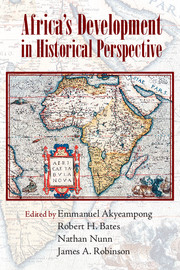Book contents
- Frontmatter
- Contents
- Author Biographies
- Acknowledgments
- Introduction
- Part I La Longue Durée
- Part II Culture, Entrepreneurship, and Development
- Part III Institutions
- Part IV External Forces
- 14 Dahomey in the World: Dahomean Rulers and European Demands, 1726–1894
- 15 The Transatlantic Slave Trade and the Evolution of Political Authority in West Africa
- 16 Gender and Missionary Influence in Colonial Africa
- Index
- References
14 - Dahomey in the World: Dahomean Rulers and European Demands, 1726–1894
Published online by Cambridge University Press: 05 September 2014
- Frontmatter
- Contents
- Author Biographies
- Acknowledgments
- Introduction
- Part I La Longue Durée
- Part II Culture, Entrepreneurship, and Development
- Part III Institutions
- Part IV External Forces
- 14 Dahomey in the World: Dahomean Rulers and European Demands, 1726–1894
- 15 The Transatlantic Slave Trade and the Evolution of Political Authority in West Africa
- 16 Gender and Missionary Influence in Colonial Africa
- Index
- References
Summary
The Kingdom of Dahomey has a bad reputation. When the debate concerning the slave trade broke out in Europe during the late eighteenth century, Dahomey was defined as the classic example of either a pariah state dedicated to the capture and sale of people to European slavers, or of a state so addicted to violence that sale of its victims was an act of mercy. Yet there is always another side to this story, and that is of a Dahomey forced by one motive or another into the slave trade. One of the earliest writers on Dahomey’s history, Robert Adams, whose work was published in 1735, argued that Dahomey opposed the slave trade but that foreign pressure compelled the kingdom to participate in it. Two influential books about Dahomey, however, written by Europeans who claimed to be eyewitnesses, one by Robert Norris in 1789 and the other by Archibald Dalzel in 1793, both published in the thick of the debate, presented Dahomey in a different light, and indeed challenged factual data from Adams’s book, to reinforce the close association between Dahomey and the slave trade (Adams and Norris 1789; Dalzel 1793).
When abolitionists won the day, and the British decided that they needed to end the slave trade, Dahomey was widely regarded as an uncooperative holdout. Reports of untrammeled slave dealing and defiance of international pressure to stop enslaving people joined continued reports of Dahomey’s violence against its neighbors and practice of human sacrifice. Ultimately these claims against Dahomey and its rulers justified the colonial occupation of the kingdom by France at the end of the nineteenth century.
- Type
- Chapter
- Information
- Africa's Development in Historical Perspective , pp. 447 - 459Publisher: Cambridge University PressPrint publication year: 2014
References
- 3
- Cited by



